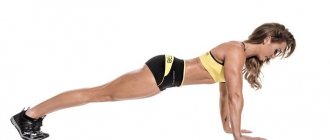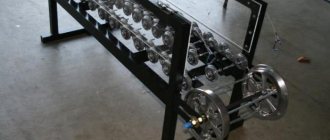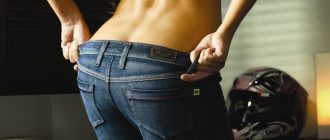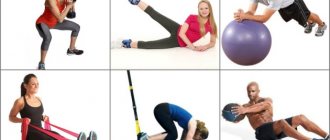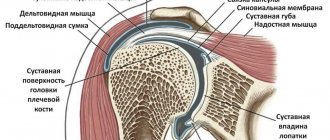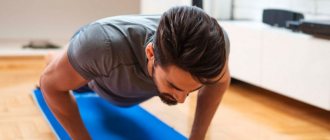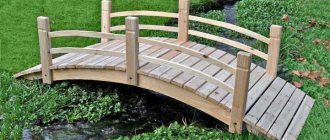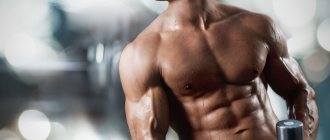6710
A modern person who wants to play sports or improve their figure no longer has to use bulky and heavy exercise equipment or various equipment for their intended purposes.
In gyms and fitness studios, everything has been done to ensure that any client is as comfortable as possible during training.
And if we are talking about training at home, then the devices may not disturb the harmony of the interior at all, or take up half the room.
One of these devices is leg weights.
Do you know about this?
- Extreme egg white diet
- Is it possible to eat watermelon at night?
Important:
- Psychology of weight loss - how to lose weight without stress
Types of models
- Lamellar. The basis of these bracelets are thick canvas fabrics, on which special pockets are sewn, and metal plates are inserted into them. With the help of such a convenient design, it is very easy and quick to adjust the weight and thereby the load by pulling out and inserting the iron plates. The service life of plate weights is much longer than printed ones, since the rubberized high-quality material does not wear out for a very long time.
- Printed. These models are simpler and more primitive. They look like fabric bags containing sand or salt filling. There are also bags with very high density, filled with metal shot or shavings. Their disadvantage is that they are not weight adjustable. To increase it, you will have to buy additional weights. Another drawback is that printed weights wear out over time and the filler spills out of them.
There are also weights for the body, weights for the wrist and arms in the form of gloves or cuffs, for the waist - in the form of a belt, for the torso - in the form of a vest.
DIY hand weights: second method (easy)
We can't always fit training into our schedule. These simple homemade weights for your arms and/or legs will allow you to exercise at home and forget about gyms and additional spending. You can use them while doing squats, lunges, and arm swings, or wear them while cooking in the kitchen or drying your hair! While you move, weights work on your figure. The benefits of sports weights are invaluable.
This option, unlike the first one, has only 4 steps , and you don’t need to be a jack of all trades.
You will need:
- A pair of long socks;
- Dry rice;
- Plastic bags.
Instructions:
- Step 1: Place equal amounts of dry rice into two bags.
- Step 2: Place one rolled and sealed rice bag in a sock.
- Step 3: Trim the ends of both socks to use as a tie.
- Step 4: Place the finished wrist weights on your wrists and get moving!
Benefits of Weighted Exercises
This sports equipment is not the most common and popular compared to more familiar equipment, such as a barbell, dumbbells, expander, etc. Let's look at the benefits of systematic training with leg weights.
- The first and most important positive effect: they promote effective weight loss. When using this equipment, the load increases, and your body burns a huge amount of calories and reduces fat layers.
- When working with weights, your endurance increases many times, your heart muscles are strengthened, and training contributes to the excellent functioning of your cardiovascular system.
- The additional load tones your muscles and makes your body more toned and sculpted, which will help get rid of excess problem areas, especially on the leg muscles, buttocks and thighs.
- With their help, it is easy to turn a regular cardio workout into a more complex and effective one. Some swimmers use weights during their pool training.
- You can greatly diversify your workouts and additionally use many other muscle groups. They can be used not only in classical training, strength or cardio, but also in yoga, Pilates, pair training, running, dancing, etc.
- By working with weights, you can form elastic buttocks, slender legs, without squats and lunges. The load is placed on the lower body and muscles, allowing you to improve your figure and many muscle groups, including the back.
After systematic and regular exercise with weights, you yourself will notice the effect of the training and how your performance and health will improve.
Ankle weights
We've looked at arm weights, now it's time to talk about how to increase the load on the leg muscles. As you may have guessed, weights come to the rescue again. They are used in a number of exercises for the abs, thighs and buttocks.
Possible harm from training
There are no particularly harmful or negative indicators. Harmful activities can only occur due to violation of safety rules.
- Weights increase pressure and put stress on the ankle and ankle, so there is a risk of injury during the training process.
- Some studies show that frequent and excessive walking or running while wearing weights can be hard on your joints and tendons.
- The pressure also falls on the hip and knee joints, so you shouldn’t immediately load yourself with a lot of weight.
Only for short accelerations
Oleg Babchin, founder and senior coach of the Second Wind school:
Running with weights can only be performed to develop speed and strength capabilities. Such exercises are performed with maximum power and in a very short time. In essence, these are accelerations of no more than 100 meters. Running long distances with weights will bring nothing but injury. Biomechanics break down, the load on the musculoskeletal system increases significantly, the emphasis shifts from sharpness and ease of movement to pulling force, which contradicts the laws of economical running.
Choosing the weight of the leg weights
It is important to remember that you need to select the weight in accordance with your physical capabilities; you should not immediately take a lot of weight that you will not be able to work with. It is better to consult your personal trainer because there may be a risk of injury.
- Many experts and trainers recommend starting with a weight of 0.5 kg and gradually increasing it. For amateurs and beginners, it is recommended not to exceed 5 kg. Cuffs weighing more than 5 kg are used by professional athletes.
- When walking or running, experts advise starting with 0.5 kg and not exceeding 1-2 kg. Over time, when the load is no longer felt, it can be doubled - and so on up to a certain weight. The bracelets should be fixed on the ankle, this will reduce the risk of injury. It is important to remember that when walking with a load, you must perform the technique correctly and set your step.
- For strength exercises, the weight is selected individually, preferably with the help of a trainer. You should know that you should increase the weight if the exercise without an auxiliary load does not produce a significant effect.
- For fitness and aerobic exercise, which women often do, weights are an essential piece of equipment that puts stress on the lower back, arms, legs, etc.
- For cardio exercises, use a weight of 0.5-1 kg. For training on the buttocks, thighs, and abs, a weight of 1 to 1.5 kg is used, but over time you can gradually increase the load to 3-4 kg.
The benefits of exercising with sports weights
- Weights can be selected depending on the required weight - for the arms or legs, and for the torso, increasing your own body weight and the degree of load in any conditions.
- As you get used to cardio training or bodyweight exercises, weights can replace sports equipment , selecting the necessary weight for the muscle groups being trained.
- Help develop small target muscles for various sports, for example, muscles of the neck, forearms.
- The weight of weights in some brands can be adjusted independently , allowing the muscles to gradually receive a new degree of load.
- Weights are suitable for all ages, professionals and amateurs, regardless of the sport.
Exercises with weights
For me one year old:
- This is an exercise to work the gluteus maximus muscle. Stand in the starting position, resting on your palms, back, knees and elbows should be in a straight position, facing the floor. We raise our legs one by one, as if pushing them away from ourselves, while the weight norm of the weights should be from 0.5 to 1 kg.
- Place your feet shoulder-width apart, place your hands on your waist and alternately swing your legs to the sides, first with one leg, then with the other.
- Standing straight, you can lean your elbows on the wall, bend your leg at the knee and move your legs back one by one, lifting them up.
How to choose body weights
- To select suitable weights, you need to take measurements of your own volumes , be it your wrists or your waist. If you choose products that match your body size, you can get a suitable load without the discomfort of chafing or weights falling off, or you can avoid buying small sizes.
- Decide on the required weight of the weight depending on your preparation. For girls, for aerobic exercise - cardio, fitness, race walking, cuffs or belts of light weight (1-3 kg) are suitable. For professionals and experienced athletes, to add weight, for example, when doing pull-ups, belts, cuffs and vests of more than 10 kg are suitable, depending on the number of repetitions.
How to make your own weights
You will need:
- Thick material, you can take jeans - 4 pieces of 55 by 30 cm.
- Velcro fastener - 2 m.
- Nylon tape - 2 m.
- Zipper fastener - 2 by 50 cm.
- Metal inserts.
- Filler.
The first option is to start by sewing two pieces of jeans together, sewing a nylon strip with Velcro in the middle, without sewing 15 cm to the edge. Insert a metal plate into the other end of the strip. As a result, we get a metal fastener insert, a nylon strip with Velcro, a nylon end and a sticky part at the end.
Another option: sew the short edges, sew a zipper into the long edge and get something like a bag. Then we divide the rectangle into 4 identical compartments, sew them, or you can sew them on a sewing machine. We fill the resulting pockets with sand, salt, cereals, metal shavings, etc.
You have learned what weights are needed for and how they are used, all that remains is to purchase them or make them yourself and start playing sports. We wish you good luck in your training!
Types of weights
Weights for running are divided into the following categories:
- Type – bulk and plate
- Weight – up to 1 kg, from 1 kg to 2.5 kg, over 2.5 kg
- Type – weights for arms, legs, vest, belt, backpack.
Plate weights
Plate weights are cuffs, belts or vests with pockets for metal plates. Their advantage is that the weight can be changed at will by adding or removing plates. Such weighting agents are stronger and more durable compared to bulk ones, however, their price is much higher.
Bulk weights
Bulk weights consist of dense fabric filled with sand or earth. They are cheaper than plate ones and are suitable for beginners as trial ones. However, their main drawback is that the weight cannot be adjusted. As some athletes note, such weights are short-lived, since the fabric begins to wear out and the sand spills out.
Hand weights come in the form of bracelets and dumbbells.
Hand bracelets
Bracelets are made of elastic or rubberized fabric. Cuffs made from thin knitwear are not durable. Their width is usually 10-15 cm, the length is adjustable with Velcro. The weight of such weights can vary from 0.5 to 5 kg.
Dumbbells
You can also use regular dumbbells or dumbbells with a special wrist mount as weights. The weight of the device should be comfortable for the runner.
Additional weight in the hands shifts the athlete's center of gravity, as a result of which the load is redistributed to other muscles. Running with dumbbells in your hands increases the load on the biceps, as well as the trapezius and deltoid muscles.
Bracelets and dumbbells increase the load on all muscle groups. But after training, the athlete usually feels more tired in the shoulder girdle, arms and upper back.
Running with a load on your arms will be useful for those who want to increase the load specifically on their arms, and also practice boxing or other martial arts. Runners with back or joint problems should limit themselves to jogging without weights.
Ankle weights
Leg weights differ from arm cuffs only in the length and width of the band. They fit over the ankle just above the shoe and fit securely on the foot. Be careful not to let the foot weight rub or slide on your ankle.
Running with weights on your legs works the soleus, gastrocnemius, and ankle muscles. Unlike a vest, leg cuffs reduce the load on the spine while working the columnar spinal muscles. This type of training also involves the rectus and oblique abdominal muscles.
Weight vest
It is worn on the upper body and resembles a bulletproof vest with many pockets for plates. The weight of the vest is adjusted depending on the type of training and the tasks that the athlete sets for himself. If you need to do endurance training, the optimal weight is 2.2 kg.
When starting to run with weights, it is better to start with equipment whose weight exceeds the athlete’s own weight by no more than 5%. By increasing the load gradually, you will avoid injuries to bones and tendons.
Belt - weighted
A belt is another type of weighting material, a lightweight version of a vest. The belt is securely fixed at the waist using a belt and does not hinder the athlete’s movements. Running with a belt allows you to pump up the muscles of your legs, abdomen, buttocks and lower back. Recommendations for choosing the optimal weight are the same as when choosing a vest.
Backpack as a weighting agent
Most often, a backpack is used as weighting material by marathon runners and other long-distance runners. The sports backpack is secured using adjustable chest and waist fastenings. Vests and backpacks for running have a high-quality ventilation and moisture removal system.
When choosing a backpack, pay attention to the position of the straps: they should fit the entire plane to the body, and not just one edge. The optimal weight of such a weighting material is 3 kg, that is, close to the weight of a backpack on the trail.
